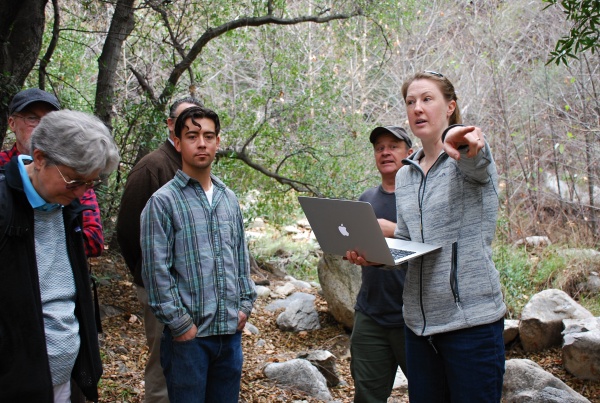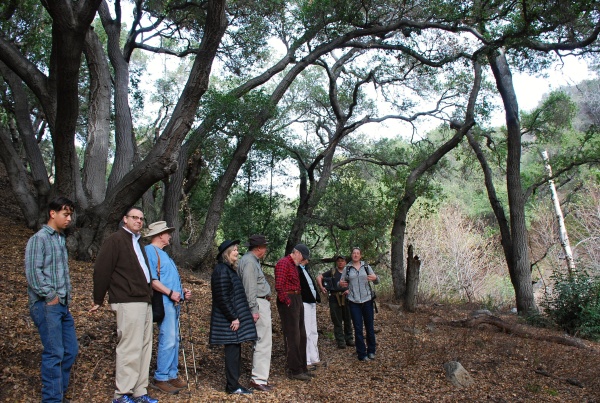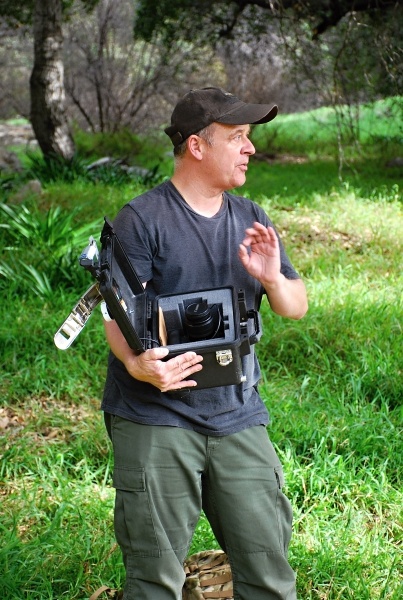Johanna Turner pointed to where she and fellow camera trapper Denis Callet found the recent deer kill in this Altadena canyon. The half-eaten carcass was found in sandy open area next to a bubbling flowing creek – and just within yards of homes situated on the ridges of either side.

“I bet those folks living up on the ridge have little idea what goes on down here,” says Callet with a grin. “We can’t wait to photograph who comes to visit here.”
Turner and Callet were leading a group from the Arroyos & Foothills Conservancy around the canyon, describing their recent scouting hikes and where they intend to place cameras to record wildlife. Their images will help document the critters in the various canyons, gulches and wild areas that the AFC has acquired throughout the years: Rubio Canyon, Millard Canyon, Rosemount Preserve, to name a few.

Just this past weekend, the duo were overjoyed to capture images of mountain lion investigating the canyon floor.


This partnership is the ultimate win/win/win for the camera trappers, land savers and wildlife.
“I’ve wanted to have a camera set up in this area for a long time,” Turner told the group. “These are some of the best corridor connections still in a nature state – and they are well-used!”
Organized in 2000, the AFC has a goal of protecting wild spaces in and around the San Gabriel and Crescenta Valleys, areas to be kept pristine and away from development; the group works to restore habitat and provide education experiences along with keeping the wild place wild.
“When you ask, ‘Why save these areas?’ wildlife always is part of the answer,” explained AFC Executive Director John Howell. “We know there are bears, mountain lions, raccoons and bobcats here. They are part of the story of this land and the best way to tell that story in with pictures.”
For the last four years, Turner and Callet have perfected the art of camera trapping and their images have been especially integral to local biologists who track mountain lions. In fact, their work and images of P-41, the only collared cougar in the Verdugo Mountains that is being studied, was featured on a recent 60 Minutes episode about mountain lions in Los Angeles.
The duo was working separately on this hobby for years until their mutual interest paths crossed. They quickly realized the old-fashioned Bushnell motion-controlled cameras weren’t giving them the high quality arty images they wanted. After all, when you invest time and energy to scout and hike into remote locations, why not get the best quality you can?

It’s all about details, Turner and Callet say. Those little markings, fur notches, eye cloudiness, etc. can help biologists recognize specific mountain lions or help tell bobcats apart. Under Callet’s MacGyver-like camera building prowess, high quality DSLR cameras were loaded into motion-controlled boxes. The results have been stunning.
Placing equipment in the wild, however, can be costly. Cameras have been slobbered on by bears and knocked over by weather not to mention being destroyed and stolen by human predators. It’s frustrating, not just for the financial outlay (both Turner and Callet pay for their cameras out of their own pocket) but for the hard work of scouting, travel time and emotional investment.
“Finally, a safe place for our cameras,” said Turner about this unspoiled wilderness that will give their image-makers plenty of subject matter and location options.
As the two lead the group into the canyon, they check sandy spots for fresh tracks, point out deer trails and search for “pinch points” where trails converge. The noisy creek runs year-round and provides multitude of “water hole” locations.
Toward the end of the hike, everyone was buzzing with potential photo opportunities; the AFC currently has a few motion-controlled cameras set up and link images to their website. A goal is to create a website and upload all the data/images which can be accessed by local schools for curriculum.

Finally, the discussion revolved around the big idea of conservation and civic involvement. Protecting wild areas has not been a high goal of many elected officials; the catalyst for conversation these days is often concerned citizens who band together to purchase, manage and protect the remaining open spaces.
“Johanna and Denis’ cameras will help us convince others of the necessity of saving the protecting these places,” sums up Howell. “When you know what you are saving, you are more apt to act and get involved.”

— Story and photos by Brenda Rees, editor

